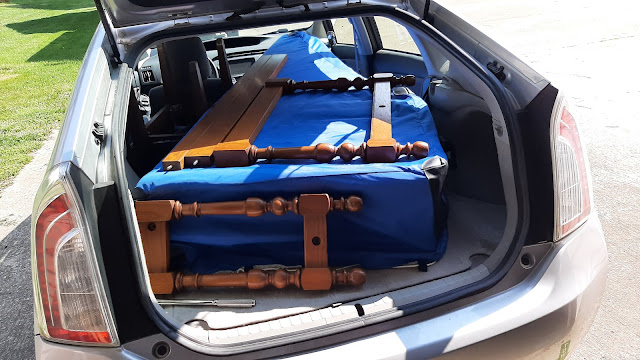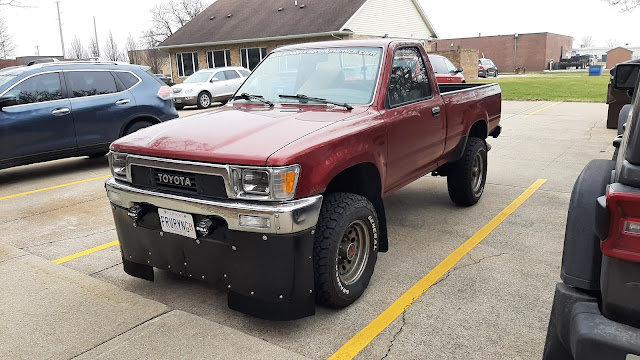Driving back and forth to a city about an hour and a half
from here for rehearsals and a concert recently, I wondered if I could measurably
improve the stability of my Prius.
 |
| I was transporting and playing this, a 2008 Zuckerman Flemish double harpsichord. You can buy kits to put an instrument like this together yourself. |
As it usually is here in the Midwest, it was windy all three
days I had to make that drive and I found myself paying attention to how much I
had to turn the steering wheel to keep the car going straight down the freeway.
I wondered, is it possible to give my car better directional stability? And
could I measure anything that would tell me, objectively, if a change I make
has an effect?
Defining “Stability”
Stability, in aerodynamics, is a complicated subject. It
depends not just on the aerodynamic characteristics of a car but also how these
interact with the car’s suspension, tires, weight distribution, and handling
tendencies. It also depends on how the driver interacts with the car. Further, we have to distinguish between static and dynamic
stability; steady-state driving conditions (say, a car driving along in still
air or a constant crosswind) is a different situation than transient (a car that
encounters a sudden gusty crosswind, for example, or a car turning in a constant wind).
I’ve already made a modification that (unintentionally) resulted
in better dynamic stability. The current version of air curtain ducts I’ve
fitted to my front bumper cover seem to improve the Prius’ response to sudden
gusts of crosswind from passing trucks, although this is a subjective
assessment. After I noticed this, I measured the pressure difference between
each side of the car in a strong crosswind. With the ducts in place, that
difference was reduced from 180 Pa to 160 Pa—so I knew the ducts do something
measurable.

That pressure difference should improve my car’s stability
in “steady” conditions too, as it means less sideforce acts on the car.
Sideforce
Sideforce, as implied by the name, is the component of
aerodynamic force that tends to push a car to one side or the other as it
drives. In order to continue on a straight path, this force must be countered by
steering in the opposite direction—and this steering is measurable!
Specifically, we can measure the steering wheel’s angle as the car drives along
a straight road in a constant wind and infer the magnitude of sideforce acting
on the car: the greater the sideforce, the larger the steering angle required to counteract it.
My first attempt at measuring this was low-tech; I opened the
Bubble Level app on my phone (which displays the phone’s angle as it rotates) and taped it to my steering wheel. Then I drove out to
the countryside on a day with 20 mph winds out of the west and found a section
of open N-S road. I measured the steering angle without and then with the cardboard
fins I’ve been testing, over a long section of exposed
road and then just after a windbreak (farmhouse with lots of trees). I found
the following:
|
|
No Fins
|
Fins
|
|
Open Section
|
8.x°-9.x°
|
10.x°-11.x°
|
|
After Windbreak
|
10.x°
|
12.x°
|
As we would expect, the increase in area results in a
greater sideforce acting on the car in a crosswind, which means I have to turn
the wheel slightly more to keep the car going down the straight road. This has
been found in wind tunnel tests of simplified car models with and without fins
as well:

But look at that second graph—that’s a plot of yawing
moment, or the car’s rotation about its center of gravity (or
another vertical reference axis; some aerodynamicists use the center of the
wheelbase). Fins increase sideforce but reduce the yawing moment, and reducing
the yawing moment and/or the yaw derivative (that is, the change in yawing
moment per change in yaw angle) can help make a car feel more stable.
Rotation
Whenever a force (or resultant of a distributed force) acts
at a distance from an axis about which it can rotate, it creates what is called
a moment. Think of tightening the lug nuts on your car’s wheel: pushing
down on the end of a wrench some distance from the nut itself causes it to
rotate. The moment can be calculated by taking the cross product of the distance/radius and force, r x F = M (bold
type here indicates vectors). Increasing
either the force or radius will increase the moment, which is why slipping a
long pipe over your wrench’s handle can help you free nuts that are otherwise
stuck with the same effort on a shorter wrench. You can think of the moment as a vector sticking out
perpendicular to the force and radius (that’s what a cross product is); to figure
out which direction that is, use the right-hand rule. Align your right hand
(not your left; this only works with the right) with the direction of the
radius as seen from the point of rotation, then curl your fingers in the
direction the force acts. With your hand in this position, stick your thumb
out; that’s the direction of the moment vector.* If that vector points “up”
along whatever you’ve defined as a positive axis, the moment is positive, and
if it points down, it’s negative. Conventionally, rotation counterclockwise as
you look at something rotating is considered positive.
After using my phone to measure steering angle, I checked
back through some of my materials and found that I could pull up an X-gauge on
the Scangauge computer to display steering angle. This should be easier to use
than the phone in future, although it turns out it only displays in intervals
of 1.6°.
Look at the bottom right part of the display (the numbers in front of "STA") and you can see that the computer reports counterclockwise
rotation of the wheel as positive, and clockwise negative:
 |
From left to right: +17.6°, 0.0°, -17.6°. |
I’ll use this display next time I get a windy day to test
and see if the resolution is small enough to be useful at all.
Unfortunately, I can’t really measure the yawing moment or
yaw derivative on the road right now (although I have some ideas I might try to
see if I can). For now, my goal will be to reduce the crosswind sensitivity of
the car in steady winds, since these are the conditions I most often encounter
on long highway drives, and I’ll use steering angle to measure that. I don’t
know if it will be possible to make huge changes, but we’ll see.
[*This is useful for any cross product, not just moments. For
example, crossing a charge passing through a magnetic field, q x B, gives the
direction of the resulting magnetic force. Pretty cool!].







Comments
Post a Comment